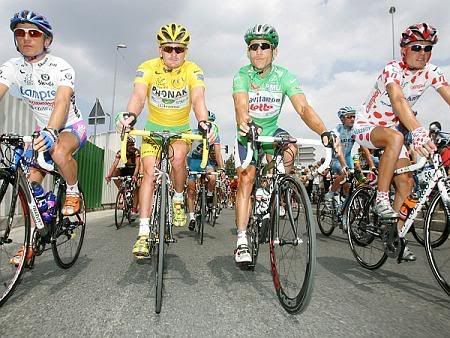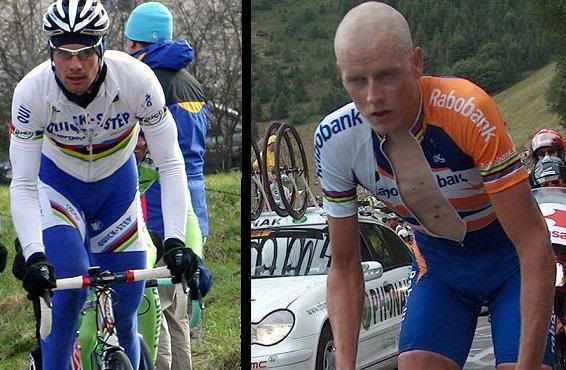There are 21 teams in this year's tour, and each team starts with 9 riders (some drop out). each team is named after their biggest sponsor (much like NASCAR), and team names often change for this reason. Riders need to race in teams because they have to draft each other, and work together to chase down breakaways.
There are a lot of different awards in the TdF, but there are four bigs ones. They are awarded with jerseys (maillots). There are the Maillot Jaune (yellow), Vert (green), Blanc (white), and Pois (white and red polka dot).
The Maillot Jaune is the leader's jersey, and is awarded to the rider with the best overall time.
The Maillot Vert is the points jersey, but it is also called the sprinter's jersey because a sprinter almost always wins it. You gain the most points by winning stages, and there are more flat stages than mountain stages. Sprinters power up to the line on the flats, so sprinters tend to win more stages, thus Sprinter's jersey.
The Maillot Blanc is awarded to the best young rider under 25. Best is determined by GC position.
The Maillot Pois is also called the King of the Mountains. This white jersey with red polka dots is awarded to the rider with the most climbing points (there are climb check points on every route).
Here are the 2006 TdF Maillots: Damiano Cunego, Floyd Landis, Robbie McEwen, and Michael Rasmussen.

Here's some jargon:
GC- General Classification. The overall standings, not just that day's race.
Peleton- The group of riders (comes from the word platoon).
Breakaway- Rider or riders that race away ahead of the peleton. They are usually caught near the end of the stage.
Bonk- Completely lose energy and power.
ITT- Individual Time trial. This is when each rider races a set course by themselves, racing for the fastest time. Riders tend to wear a lot of aero gear to shave off time.
Aero- short for aerodynamic.
TTT- Team time trial. Same as ITT, only five riders race as a group. The last rider over the line is the time for the whole team. There are no TTT in this year's tour.
Saddle- bike seat. Announcers will says 'he's out of the saddle' when a rider stand up on his bike.
EPO- Erythropoietin. This is a chemical produced by your kidneys to regulate the production of red blood cells. Dopers will take it to increase their rbc count, which increases endurance.
Note on Sprinters vs Climbers.
A sprinter cannot win the Tour de France. Sprinters are bigger guys, with powerful thighs and gluts that help them reach speeds of up to 60mph in order to win flat stages. Because of their additional muscle weight, they tend to suffer in the mountains. Some drop out altogether. Climbers are also very strong riders, and occassionally they win sprints, but usually they stick to winning in the mountains. They are a lot smaller than sprinters for this reason: When you climb up hill, every ounce of additional weight pulls against you and decreases your time. Some riders like Michael Rasmussen are so obsessed with reducing weight that they shave all their body hair. Here is Sprinter Tom Boonen compared to climber Michael Rasmussen:

No comments:
Post a Comment